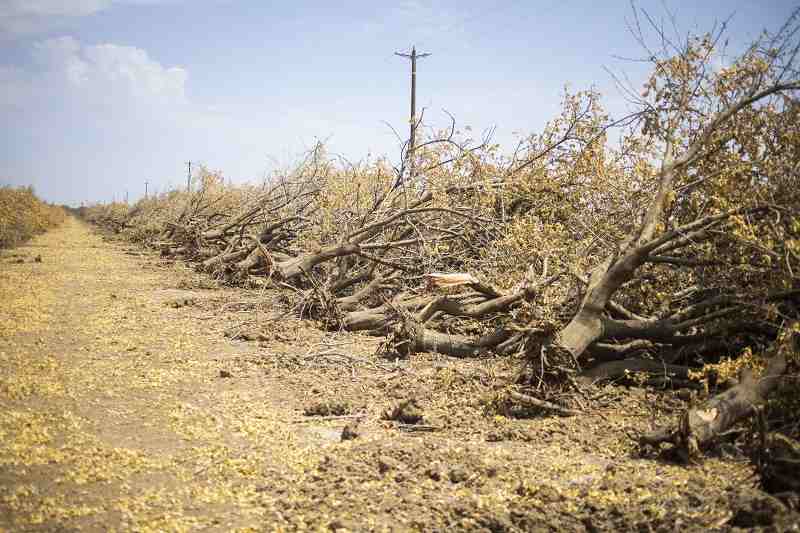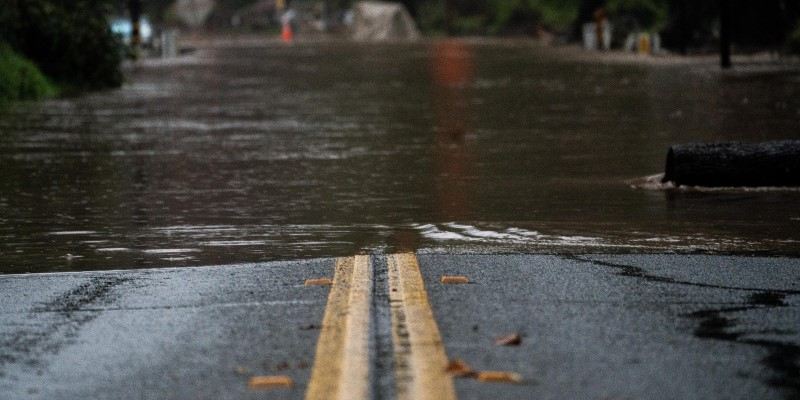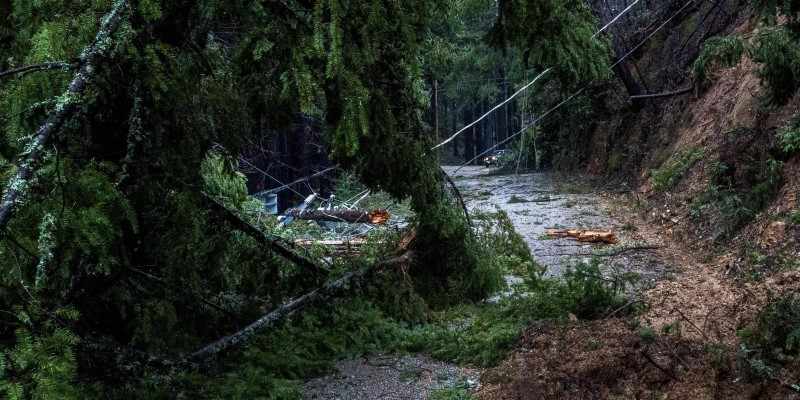
Dead almond trees lie in a California orchard during drought.
12:56 JST, January 11, 2023
It wasn’t so long ago that California prayed for rain. Something to quench the climate-change-fueled drought – the worst in at least 1,200 years – that has caused farm fields to wither and wells to run dry. To ease the blistering heat waves that triggered power outages and sent thousands to emergency rooms. To extinguish the wildfires that have ravaged forests, destroyed communities and blackened the skies.
Now, the water that Californians so desperately wanted is pummeling them like a curse. It’s surging over riverbanks and rushing through communities, toppling drought-stressed trees, turning scorched mountainsides into avalanches of mud. The storms cut off power to roughly 150,000 customers across the state Tuesday. The flooding prompted evacuations in Montecito and other parts of Santa Barbara County, and swept away a 5-year-old boy who still has not been found. Officials said at least 16 people have been killed by the storms of the past two weeks – more than the number of lives lost in wildfires over the last two years.
The recent onslaught of atmospheric rivers has underscored the perils of California’s climate paradox: Rising global temperatures are making the region drier, hotter and more fire-prone, but they also increase the likelihood of sudden, severe rainfall. Experts say the state is not prepared for periods of too much water, even as it struggles to make do without enough.
“Water scarcity in California, for good reason, has been all-consuming,” said hydrologist Jeffrey Mount, a senior fellow at the Public Policy Institute of California and professor emeritus at the University of California at Davis. “But you can’t take your eyes off the wet periods [and] how to prevent catastrophic flooding. . . . That’s the big time challenge.”
California’s escalating droughts and intensifying storms represent two sides of the same meteorological coin. Both are tied to the fact that every one-degree Celsius increase in temperature allows air to hold 7 percent more moisture. This makes the atmosphere “thirstier” during dry seasons, causing it to suck water out of vegetation and soils.
But it also means there’s more water available to storms. So when it rains, it pours.
Human-caused climate change, driven mostly by the burning of fossil fuels, has warmed California by about 1.4 degrees Celsius (2.5 degrees Fahrenheit) since 1895, according to a 2022 report from the California Environmental Protection Agency. Scientists say this temperature rise is exacerbating California’s naturally “boom-bust” climate, characterized by dry summers and wet winters.
An emerging body of research known as attribution science has showed that climate change is responsible for about 42 percent of the ongoing severe drought that has afflicted the western United States since the start of the 21st century.
Researchers are still teasing out the climate connection in California’s recent spate of storms. But models suggest that atmospheric rivers – which have historically supplied half of California’s water – are getting stronger and will continue to intensify as the planet warms. A 2018 study in the journal Geophysical Research Letters predicted that these plumes of tropical moisture will become 25 percent longer and wider under the worst-case warming scenarios. Another study in the same journal found that escalating atmospheric rivers will shift from being mostly beneficial to mostly hazardous, even as they account for a growing portion of California’s strained water supply.
“We’ve always had tremendous variability,” Karla Nemeth, director of California’s Department of Water Resources, said in an interview. “What’s happening is you add climate on top of that and you’re just stretching out the extremes.”
Decades of questionable planning decisions has made the state vulnerable to disasters on both ends of the spectrum, Mount said. Farmers and cities have pumped too much groundwater, causing land to sink and giving communities little to fall back on during dry periods. In the past two decades, the aquifer beneath the Central Valley has lost as much as 9.2 cubic kilometers of water per year, according to NASA satellite data. That’s more than the volume of Shasta Lake, California’s largest reservoir.
At the same time, the state heavily altered its rivers – constructing dams, building levees on their banks, straightening out their twists and curves. This eliminated the rivers’ natural floodplains, making it more difficult for groundwater to replenish. Making matters worse: Communities have been built on those floodplains, so when rivers overtop their banks, the water goes into people’s houses rather than replenishing wetland habitats and slowly sinking into the soil.
Santa Cruz County, which has been inundated during the recent storms, is a prime example of this “engineering hubris,” Mount said.
In the late 1950s, the Army Corps of Engineers “channelized” the San Lorenzo River to make it run deeper and faster, and built levees upstream to manage flows. According to an analysis by UC-Santa Cruz professor Gary Griggs, virtually all of downtown Santa Cruz was built in what had been the river’s 100-year flood plain.
But the construction also contributed to sediment buildup, diminishing the river’s capacity to control floods. As the planet warms, escalating storms will increasingly overwhelm systems that weren’t designed for such extremes.
“The things we did in the past to manage water are going to be insufficient in the present, much less the future,” Mount said.

The Lorenzo River overflows onto California Highway 9, trapping cars and neighborhoods in Santa Cruz, Calif., on Monday.
The San Lorenzo River hit its second-highest level in 85 years on Monday, cresting more than eight feet above flood stage, according to the Santa Cruz Sentinel.
Residents said recent fires and drought made their community even more vulnerable to this year’s storms. In 2020, the Lightning Complex fires scorched more than 86,000 acres across the region, including the towering redwood forests of Big Basin state park. Now, the burned areas are less able to absorb the onslaught of rain. Slopes are collapsing without vegetation to hold the soaked soil in place. Dead trees are being ripped from their roots and carried downstream.
“All the trees up and down the hillside that have been burned, they’re flooding up the river, so the river can’t run freely,” Bethany Rogers said. She had fled her home in the Felton Groves community north of Santa Cruz during the fires. On Sunday, she had to evacuate again.
Dealing with a hotter, drier climate reality has become a way of life for many Californians. The state has been in a drought state of emergency since 2021. Residents have dealt with restrictions on lawn watering, crop irrigation and other water uses on and off since 2014.
The state has invested more than $8 billion in water conservation and storage measures over the last two years, and last summer Gov. Gavin Newsom (D) released a 19-page document outlining his strategy for preparing for future droughts.
But critics say California hasn’t done as much to ready itself for the times when too much rain falls. Though the state Senate last year proposed a $1 billion investment in flood management and dam safety, most of the provisions were dropped from the budget that ultimately passed.
“For water agencies, flood management tends to be the poorer stepchild of water supply issues,” said Deirdre Des Jardins, director of California Water Research, which conducts analysis on state water planning processes and advises environmental groups. She said the political pressure from farm groups, municipal water managers and other constituencies is focused on ensuring water access, rather than fending off floods that studies show disproportionately threaten low-income communities.
Des Jardins has been alarmed by recent research suggesting that climate change has already doubled the chance of California seeing a catastrophic megaflood and could increase the likelihood of such a deluge by as much as 400 percent.
“We’re just not taking those kind of extreme floods into account in our emergency planning,” she said.
California’s hyper-focus on water scarcity is also a product of what Mount calls “the half-life of disaster memory.” People tend to forget about severe storms once the floodwaters recede. But droughts are long, drawn-out disasters, he said – creating a longer window of public attention for officials to implement conservation plans.
In a report released in November, Mount and his colleagues at the California Public Policy Institute called on the state to develop a comprehensive “wet year strategy” for preventing flooding and capturing rainfall as a buffer against future drought. New stormwater capture systems in cities and river bypasses that redirect floodwaters into ecosystems and farm fields can help avert flood damage and recharge depleted groundwater, the report said.
“The actions we take (or fail to take) during wet years sow the seeds for our successes (or our challenges) during drought,” the authors wrote.
Nemeth, the Department of Water Resources director, acknowledged that the state has “a lot of work to do” to grapple with the deluges that will come in a warmer climate. But she also touted flood protection projects that are already underway.
The department has taken part in tabletop exercises, known as ARkStorm, where state and federal agencies simulated their response to a 1-in-1000-year atmospheric river event. The agency is working with farmers to promote groundwater recharge projects and with reservoir managers to incorporate more sophisticated weather forecasting into their operations.
In 2021, California gave out more than $23 million in grants for coastal flood risk reduction, including $7 million to Santa Cruz County. Newsom’s proposed state budget, announced Wednesday, includes more than $200 million for flood prevention projects.
An increase in catastrophic storms “has been in the wings, predicted for a while,” Nemeth said. “But there’s nothing like being in it to start to shake off the old ways of doing business.”

Fallen redwood trees covered the roadway and pulled down power lines in Santa Cruz on Tuesday.
"News Services" POPULAR ARTICLE
-

American Playwright Jeremy O. Harris Arrested in Japan on Alleged Drug Smuggling
-

Japan’s Nikkei Stock Average as JGB Yields, Yen Rise on Rate-Hike Bets
-

Japan’s Nikkei Stock Average Licks Wounds after Selloff Sparked by BOJ Hike Bets (UPDATE 1)
-

Japanese Bond Yields Zoom, Stocks Slide as Rate Hike Looms
-

Japan’s Nikkei Stock Average Buoyed by Stable Yen; SoftBank’s Slide Caps Gains (UPDATE 1)
JN ACCESS RANKING
-

Keidanren Chairman Yoshinobu Tsutsui Visits Kashiwazaki-Kariwa Nuclear Power Plant; Inspects New Emergency Safety System
-

Imports of Rare Earths from China Facing Delays, May Be Caused by Deterioration of Japan-China Relations
-

University of Tokyo Professor Discusses Japanese Economic Security in Interview Ahead of Forum
-

Japan Pulls out of Vietnam Nuclear Project, Complicating Hanoi’s Power Plans
-

Govt Aims to Expand NISA Program Lineup, Abolish Age Restriction



















